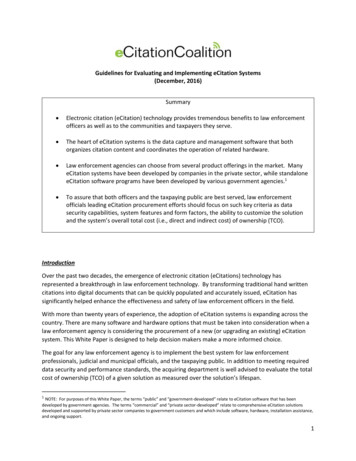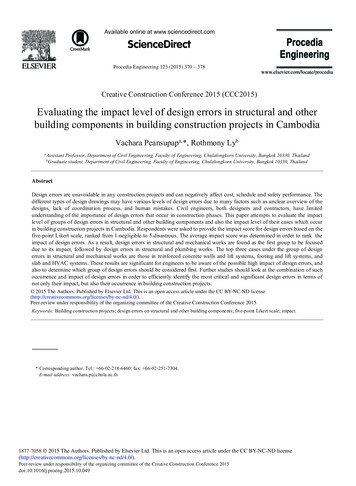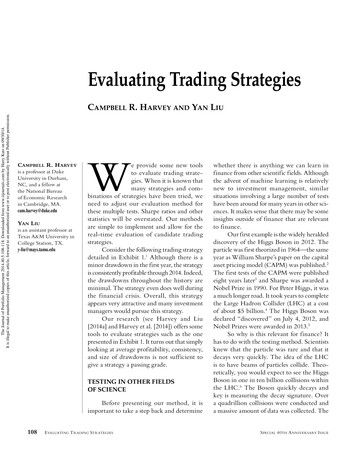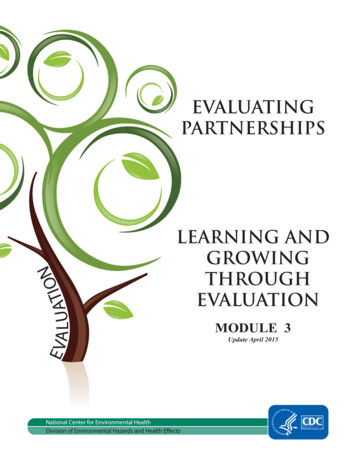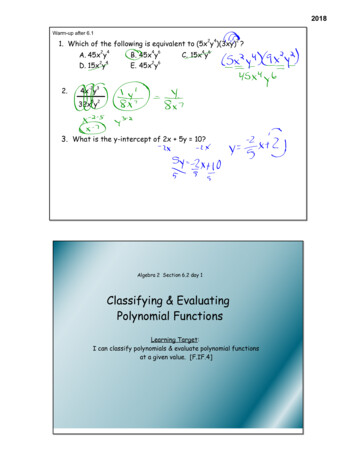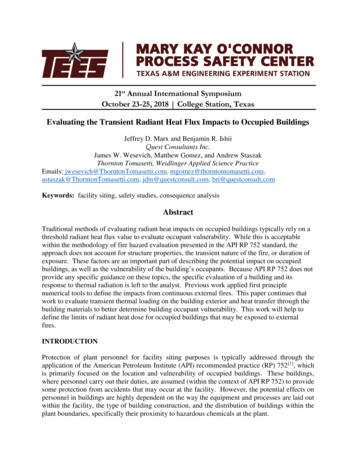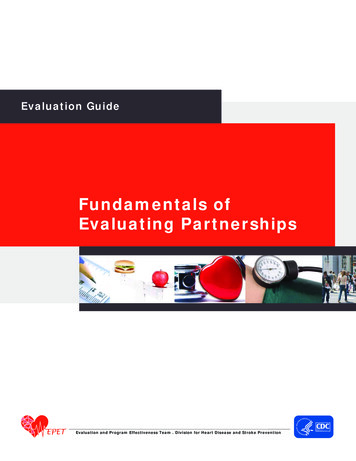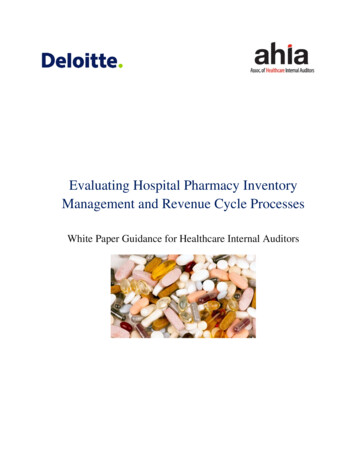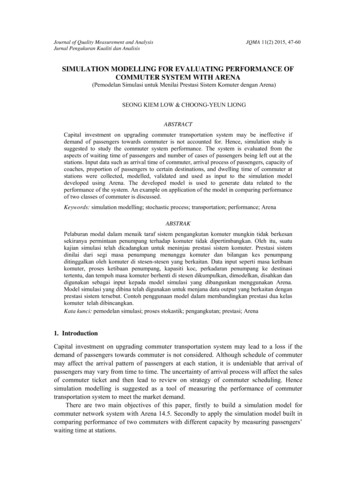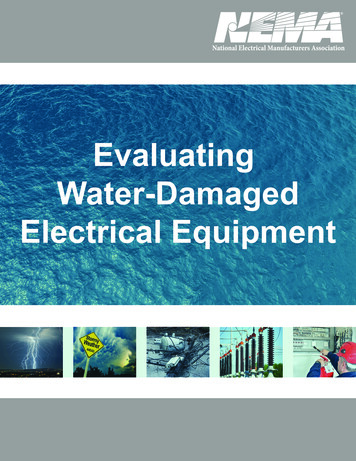
Transcription
2015 ASEE Southeast Section ConferenceIntroducing a Tool for Evaluating Course Objectives (TECO)for a new Engineering ProgramMonika Bubacz and Robert RabbThe Citadel, Charleston, SCAbstractThe Citadel School of Engineering has initiated a Bachelor’s of Science in MechanicalEngineering program in the fall 2014. During the first semester various classes have beenoffered to freshmen, sophomores and juniors. This paper will describe an evaluation tool, TECO– a Tool for Evaluating Course Objectives, used throughout the semester that allowsinstantaneous assessment, analysis and continuous improvement that can be implemented beforethe end of semester. This evaluation tool will also produce an archival record of all courseassessment activities. As a spreadsheet it is easy to navigate, manage and adjust, and verytransparent to evaluators as it shows all graded work and how those activities support the courseobjectives. As a course planning tool, the matrix will show where there are shortfalls andstrengths in the course content and will allow instructors to adjust requirements before the termends.KeywordsABET accreditation, course objectives, new engineering programABET AccreditationABET is a non-profit and non-governmental accrediting agency for academic programs in thedisciplines of applied science, computing, engineering, and engineering technology.1 ABET is arecognized accreditor in the United States by the Council for Higher Education Accreditation.ABET accreditation provides assurance that a college or university program meets the qualitystandards established by the profession for which the program prepares its students. To date,ABET has accredited over 3,400 applied science, computing, engineering, and engineeringtechnology programs at nearly 700 colleges and universities in 28 countries worldwide.The ABET accreditation gives an assurance that the professionals that serve the population havea solid educational foundation and are capable of leading the way in innovation, emergingtechnologies, and in anticipating the welfare and safety needs of the public. Thus theaccreditation impacts students, programs and institutions, businesses, industry, government andthe public.The ABET accreditation is a process where educational programs or institutions are reviewed todetermine if they meet certain standards of quality. The accreditation is not a ranking systembut an assurance that a program or institution meets established quality standards. The ABETengineering accreditation criteria cover all aspects of program evaluation, from high levelinstitutional program educational objectives down to individual program outcomes, includingevaluation of a program’s continuous improvement processes.2 American Society for Engineering Education, 2015
2015 ASEE Southeast Section Conference Program Educational Objectives are broad statements that describe what graduates areexpected to attain within a few years of graduation. Program educational objectives arebased on the needs of the program’s constituencies. Student Outcomes describe what students are expected to know and be able to do by thetime of graduation. These relate to the knowledge, skills, and behaviors that studentsacquire as they progress through the program. Student outcomes should be defined inorder for faculty to have a common understanding of the expectations for student learningand to achieve consistency across the curriculum, as measured by performance indicators.Performance indicators represent the knowledge, skills, attitudes or behavior studentsshould be able to demonstrate by the time of graduation that indicate competence relatedto the outcome. Assessment is one or more processes that identify, collect, and prepare data to evaluatethe attainment of student outcomes and program educational objectives. Effectiveassessment uses relevant direct, indirect, quantitative, and qualitative measures asappropriate to the outcome or objective being measured. Appropriate sampling methodsmay be used as part of an assessment process. Understanding the alignment between educational practices and strategies promotesefficient and effective assessment practices. This can be accomplished by mappingeducational strategies (which could include co-curricular activities) to learning outcomes. Evaluation is one or more processes for interpreting the data and evidence accumulatedthrough assessment processes. Evaluation determines the extent to which studentoutcomes and program educational objectives are being attained. Evaluation results indecisions and actions regarding program improvement.The New Mechanical Engineering Program at The CitadelThe Citadel School of Engineering has had a proud record of significant contributions at TheCitadel since its inception in 1842.3 The Civil and Environmental Engineering Department wasestablished in 1912 and became accredited in 1936. The Electrical and Computer EngineeringDepartment was established in 1941 and became accredited in 1976. The MechanicalEngineering Program was added in 2014 with the first mechanical engineering courses (MECH)offered in the fall. The School of Engineering will apply for accreditation of the newMechanical program as soon as the first mechanical engineering students graduate, which isexpected in May 2016.The new Mechanical Engineering Program of Study offers focused tracks in Power and Energy,Manufacturing, Aeronautical Systems, Materials (Composites), and Mechatronics. It isavailable to the cadet population as well as to the evening students transferring from partneringcommunity and technical colleges (2 2 programs). The full-time evening MechanicalEngineering program mirrors the current full-time evening 2 2 programs in Civil and ElectricalEngineering. American Society for Engineering Education, 2015
2015 ASEE Southeast Section ConferenceThe new program courses have been prepared using the ABET engineering accreditation criteriaand the new team of mechanical engineering faculty is working on collection, assessment andevaluation of the courses in order to provide a quality educational experience for students.Currently Introduction to Mechanical Engineering is offered to the freshman and sophomorecadets and Thermo-Fluids, Computer Aided Design, and Engineering Materials are offered to theevening transfer juniors. The authors believe that a transparent, well-understood process ofcontinuous data collection and course assessment and evaluation is crucial for the success of thenew program. Also, early improvement and goal-oriented changes will keep the program viablein the long term.The new mechanical engineering courses are already thoroughly described and approved by theSouth Carolina Commission on Higher Education. Each one has a list of course objectiveswhich are being used to evaluate the courses. Once a course is taught, it is critical that eachfaculty member reviews and critiques the assessment instruments and assessment indicators usedto evaluate the course. This ensures the validity of not only the course material, but theevaluation material as well2. The course evaluation materials will be archived and used in theprogram evaluation process for the future ABET accreditation.The Tool for Evaluating Course Objectives (TECO)The Mechanical Engineering Program faculty members proposed to use a unified tool forevaluating MECH course objective which will be called TECO. The tool has been based on atool used by the United States Military Academy to assess their Mechanical EngineeringProgram and Engineering and Technology outcomes.4 Each course outcome is evaluated byusing embedded indicators which consist of selected graded events that are contained within thecourse. Each embedded indicator is described and the average grade, the standard deviation ofthe individual grades and the possible number of points possible for the graded event arerecorded. The data for each embedded indicator is then entered into the appropriate courseoutcome column. Once all data is entered into the spreadsheet, it automatically computes theaverage and standard deviation for each course outcome.This form of evaluation is being currently used by the ME faculty in one of the new ME courses,a junior level MECH 304 Engineering Materials, and the outcomes of this new effort will beidentified in December 2014. All graded work: homework, projects, quizzes and tests withseparated questions, is placed in a matrix allowing an immediate course outcomes assessmentand possible changes of future assignments in order to add more embedded indicators whereneeded, review ‘muddy points’ with students and work on ‘weak spots’ of the course. A shortsyllabus for MECH 304 can be found in Table 1 and the TECO matrices for this course areshowed in Figures 1 and 2. The authors’ goal is that TECO will provide a better, unified,consistent, efficient and transparent evaluation and report across all courses in the new program.The instructor graded all assignments and partial credit was incorporated. American Society for Engineering Education, 2015
2015 ASEE Southeast Section ConferenceTable 1. MECH 304 Engineering Materials abbreviated syllabusTHE CITADELTHE MILITARY COLLEGE OF SOUTH CAROLINADepartment of Engineering Leadership and Program ManagementMECH 304 Engineering Materials with LabCourse SyllabusFall 2014Course Description:Course explores the relationships between the microscopic structure and macroscopic properties ofmaterials used in engineering applications. The origin of mechanical, electrical, and thermal properties isstudied. Important material failure modes such as occur under fatigue, elevated temperature, rapidloading and corrosive environments are explored. Emphasized is an understanding of the fundamentalaspects of atomic and microstructural concepts for proper materials selection, effects of processing onmaterial properties, and enhancement of engineering properties. Materials under study include importantmetals and alloys as well as key nonmetallic materials such as polymers, ceramics, and composites.Laboratory exercises are integrated throughout the course to provide practical experience in makingdecisions concerning material composition and processing in order to optimize engineering properties.Experiences from the field are detailed to demonstrate applicability of concepts. Lecture: two hours.Laboratory: two hours.Course Objective:Upon successful completion of this course, you should be able to do the following:1) Classify engineering materials2) Understand their structure and properties3) Evaluate engineering properties4) Perform design /material selection for a given engineering problem.Course Outcomes:Students who successfully complete the course requirements should:1) Describe and contrast the classes of engineering materials in terms of general microstructure,properties, failure mechanisms and application (ceramics, polymers, composites, biomaterials,nanotechnology, and smart materials).2) Determine how the atomic structure of materials influences physical and mechanical properties.3) Distinguish between microstructures utilizing isomorphous and binary phase diagrams to computephases, compositions and amounts of elemental constituents.4) Apply processing and strengthening mechanisms to optimize physical and mechanical properties.5) Apply materials science concepts and knowledge to the proper selection of engineering materialsutilizing previously learned engineering principles.Topics covered:1) Atomic Structure, Properties and Material Selection (metals, ceramics, polymers)2) Composites3) Defects4) Diffusion5) Strengthening Mechanisms6) Phase Diagrams7) Nanomaterials8) Biomaterials9) Smart Materials10) Semiconductors/Superconductors American Society for Engineering Education, 2015
2015 ASEE Southeast Section Conference1) Describe and contrast the classes ofengineering materials in terms ofgeneral microstructure, properties,failure mechanisms and applicationEmbedded IndicatorsIndicatorDescriptionHW 1Material research1000.00%1010010HW 2Atomic structure1000.00%1010010HW 3Crystal structure1000.00%10HW 4Crystal structure1000.00%1010010HW 5Solid solutions1000.00%1010010HW 6Diffusion1000.00%10HW 7Mech. Properties1000.00%10HW 0840T1 /5,9,11,12 Crystal structure2) Determine how the atomic structureof materials influences physical andmechanical properties.3) Distinguish between microstructuresutilizing isomorphous and binary phasediagrams to compute phases,compositions and amounts of elementalconstituents.4) Apply processing and strengtheningmechanisms to optimize physical andmechanical properties.5) Apply materials science concepts andknowledge to the proper selection ofengineering materials utilizingpreviously learned engineeringprinciples.Avg Pts Earned Stnd Dev Pts Stnd Dev % Pts Pssible Avg Pts Earned Stnd Dev Pts Pts Pssible Avg Pts Earned Stnd Dev Pts Pts Pssible Avg Pts Earned Stnd Dev Pts Pts Pssible Avg Pts Earned Stnd Dev Pts Pts Pssible Avg Pts Earned Stnd Dev Pts Pts T1 /6,7,8,10Properties383.468.66%40HW 9Cold work1000.00%10HW 10Failure1000.00%10HW 11Phase diagrams1000.00%1010010HW 12Phase diagrams1000.00%1010010HW 13Phase transform.9.670.585.77%109.670.5810T2 /5,6Strengthening17.331.537.64%20T2 /7,8,9Phase diagrams26.336.5116.27%40T2 /10Decarborization17.005.2025.98%20HW 14Metal processing1000.00%10P1Heat treatment95.673.063.06%100HW 15Ceramics1000.00%10HW 16Ceramic process.1000.00%10Q1Steel microstruct.6.50.717.07%10HW 17Polymers9.670.585.77%109.670.5810HW 18Polymer process.1000.00%10100HW 19Composites1000.00%1010Q2Steel microstruct.1000.00%10T3 /5,6,11Poly and cer struct.15.671.537.64%2015.67T3 /7,8Poly and cer. prop.19.001.738.66%20T3 /9,12,13Steel microstruct.20.005.2017.32%30T3 /10Polymers compar.9.750.585.77%10HW 20Electr. and magn.9.331.1511.55%10HW 21Thermo and optic1000.00%P2Advanced 3209.750.58101001020.005.2030HW 96.3%77.1%95.3%97.6%Stnd Dev2.8%6.4%10.8%4.7%2.6%Figure 1. TECO matrix for MECH 304 a week before the final exam American Society for Engineering Education, 2015
2015 ASEE Southeast Section Conference1) Describe and contrast the classes ofengineering materials in terms ofgeneral microstructure, properties,failure mechanisms and applicationEmbedded IndicatorsIndicatorDescriptionHW 1Material research1000.00%1010010HW 2Atomic structure1000.00%1010010HW 3Crystal structure1000.00%10HW 4Crystal structure1000.00%1010010HW 5Solid solutions1000.00%1010010HW 6Diffusion1000.00%10HW 7Mech. Properties1000.00%10HW 0840T1 /5,9,11,12 Crystal structure2) Determine how the atomic structureof materials influences physical andmechanical properties.3) Distinguish between microstructuresutilizing isomorphous and binary phasediagrams to compute phases,compositions and amounts of 10383.464010010Properties383.468.66%40HW 9Cold work1000.00%10HW 10Failure1000.00%10HW 11Phase diagrams1000.00%1010010HW 12Phase diagrams1000.00%1010010HW 13Phase transform.9.670.585.77%109.670.5810T2 /5,6Strengthening17.331.537.64%20T2 /7,8,9Phase diagrams26.336.5116.27%40T2 /10Decarborization17.005.2025.98%20HW 14Metal processing1000.00%10P1Heat treatment95.673.063.06%100HW 15Ceramics1000.00%10HW 16Ceramic process.1000.00%10Q1Steel microstruct.6.50.717.07%10HW 17Polymers9.670.585.77%109.670.5810HW 18Polymer process.1000.00%10100HW 19Composites1000.00%1010Q2Steel microstruct.1000.00%10T3 /5,6,11Poly and cer struct.15.671.537.64%2015.67T3 /7,8Poly and cer. prop.19.001.738.66%20T3 /9,12,13Steel microstruct.20.005.2017.32%30T3 /10Polymers compar.9.750.585.77%10HW 20Electr. and magn.9.331.1511.55%10HW 21Thermo and optic1000.00%P2Advanced matr.96.672.89HW 22Corrosion9.67Final /5,6,8Mat. properties20.67Fin. /2,4,9,10 Steel microstruct.Final /1,3,7Totals5) Apply materials science concepts andknowledge to the proper selection ofengineering materials utilizingpreviously learned engineeringprinciples.Avg Pts Earned Stnd Dev Pts Stnd Dev % Pts Pssible Avg Pts Earned Stnd Dev Pts Pts Pssible Avg Pts Earned Stnd Dev Pts Pts Pssible Avg Pts Earned Stnd Dev Pts Pts Pssible Avg Pts Earned Stnd Dev Pts Pts Pssible Avg Pts Earned Stnd Dev Pts Pts PssibleT1 /6,7,8,10Mat. Comparison4) Apply processing and strengtheningmechanisms to optimize physical andmechanical 0Assessment89.3%96.3%79.3%95.3%95.9%Stnd Dev7.5%6.4%11.0%4.7%4.7%Figure 2. TECO matrix for MECH 304 after the final exam American Society for Engineering Education, 2015
2015 ASEE Southeast Section ConferenceBased on the results collected up to the final exam (Figure 1) it can be seen that the courseoutcome 3 gave the lowest assessment score (77.1%), see Table 2. Therefore it was reevaluatedduring the final. Also the number of embedded indicators for this outcome was the lowest, thusit should be tested more in the future. The instructor of the course suggests using more quizzesand possibly a project or other individual assignments. If the assessment score stays low theinstructor should focus more on teaching and reviewing the troublesome topics. This year duringa review before the final exam the instructor went over course material, previous tests questionsand homework problems related to outcome 3. Figure 2 and Table 2 show how the addedembedded indicators selected for the final exam changed the assessment results.Table 2. TECO summary for MECH 304Before and after Before2After1BeforeCourse .3%95.3%97.6%95.9%Standard %Number of embeddedindicators12131313781111911ConclusionsThe TECO tool provides a common basis for evaluation across all program courses, adds easeof-use and transparency to the evaluation efforts, and produces a concise, useful set of courseevaluation data. The course outcomes assessment shown indicates that all outcomes weresupported by each of the embedded indicators. The course instructor observed an increase incourse visibility, better and more efficient course planning, better course assessments andevaluations, and expects reductions in the time required to perform end-of-course evaluations.The authors hope TECO will provide increased program visibility, more consistent reportingacross all courses in the program, and a greatly improved process of on-going data gathering,analysis, and program evaluation. The TECO is also planned to be used for ABET studentoutcomes evaluations in the future. The transition from course objectives to ABET outcomesshould be relatively easy once the tool is fully developed and commonly utilized.AcknowledgementsThe authors would like the acknowledge the Department of Civil and Mechanical Engineering atthe United States Military Academy for sharing their Mechanical Engineering ProgramAssessment Tool, which served us as a template for TECO. American Society for Engineering Education, 2015
2015 ASEE Southeast Section ConferenceReferences1234ABET, retrieved from http://www.abet.orgNordstrom G., Pettit J., “A Syllabus-Based Assessment
The Citadel School of Engineering has initiated a Bachelor’s of Science in Mechanical Engineering program in the fall 2014. During the first semester various classes have been offered to freshmen, sophomores and j
